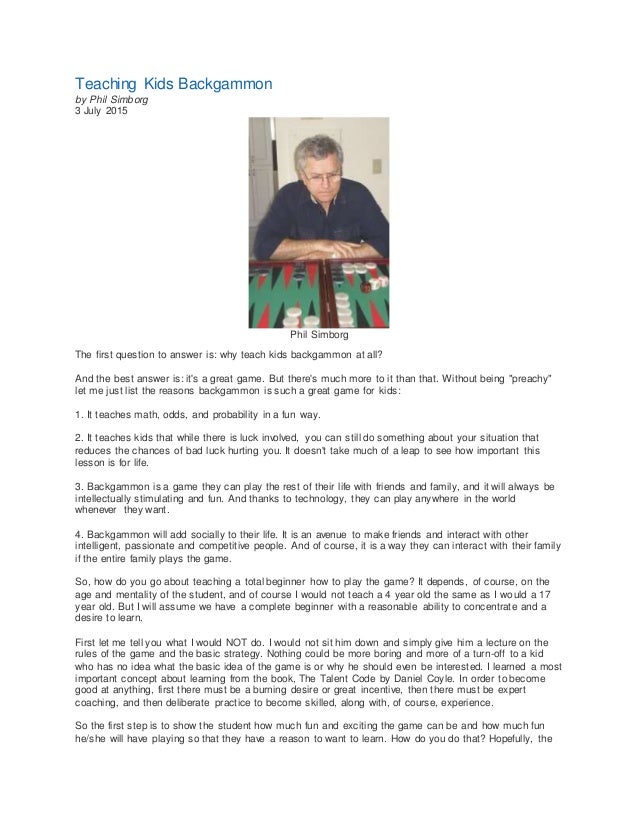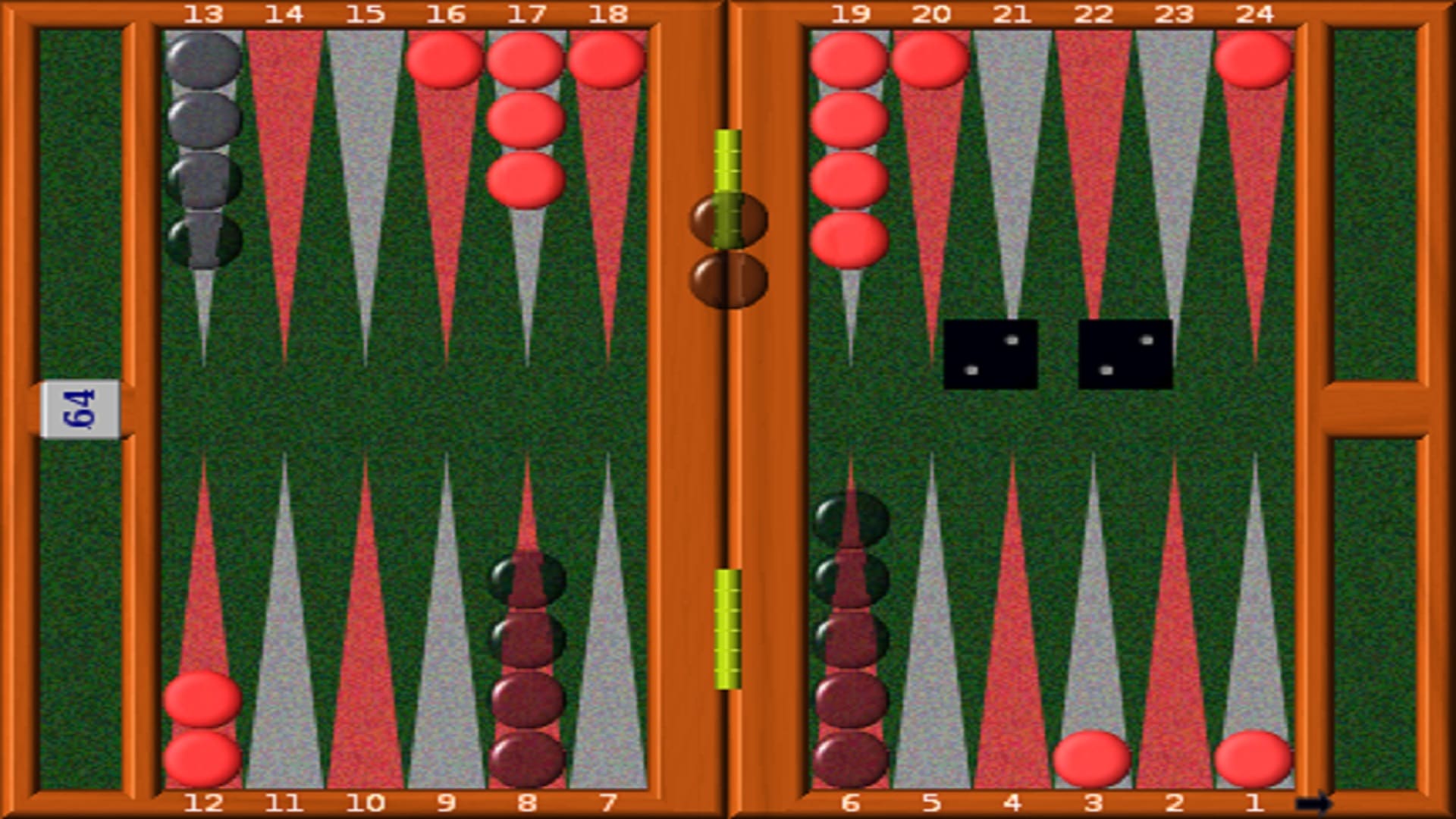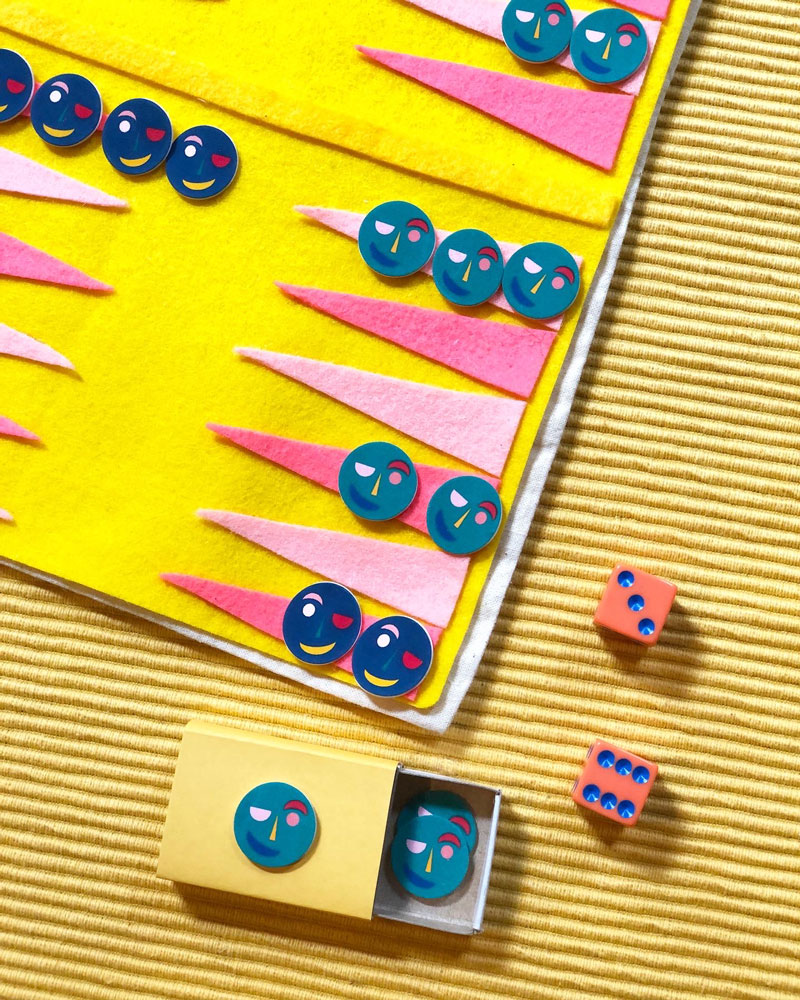How To Backgammon
247 Backgammon offers the best backgammon game online. Play with an artificially intellegent opponent or play with a friend with Pass & Play! 247 Backgammon has games in five difficulites, ranging from easy to expert! You'll be sure to find a difficulty you feel comfortable playing, whether you are a beginner or seasoned backgammon player. Options only on 247 Backgammon include doubling cube, highlights, match points, and chip color! This backgammon site even remembers your preferences every time you come back so you'll be set to play immediately! The gameplay on 247 Backgammon is seamless and you'll quickly become addicted to the beautiful artwork and perfect puzzle game.
Backgammon is a member of the tables family, one of the oldest classes of board games. Backgammon involves a combination of strategy and luck (from rolling dice). While the dice may determine the outcome of a single game, the better player will accumulate the better record over a. Setting Up the Game. Lay the game board lengthwise between both players and assign each player.
Backgammon is a popular ancient board game. It is played with two players (lucky you, we have a computer player to enjoy!). The object of backgammon is to move all your checkers around the board in a clockwise motion and ultimately bear off the checkers from the board. The first player to remove all their checkers is the winner.
Each player places 2 pieces on the 24 point, 5 pieces on the 13 point, 3 on the 8 point and 5 on the six point. Always arranged in a vertical line. The Objective of Backgammon / How to Win. The objective of the game is to bear off each of your own pieces before the opponent. Backgammon is a game of tactics, but it is also a game of chance. Two players move 15 pieces (checkers) around a board with 24 triangles (points) in an attempt to get all their pieces around and off the board. To move their pieces, the players roll two dice to determine how far they can travel.
Alternate turns with your opponent moving checkers toward your home in the upper right hand quadrant of the backgammon board. Move checkers by rolling the dice. The numbers on the dice refer to how many spaces you may move with one or more checkers. Highlights show you where the checkers can possibly move. If you roll doubles, you get to move each die twice, concluding in four moves for that turn. You may move your checkers onto any Point so long as it is occupied by your checkers, is empty, or has 1 opponent checker. You may not move your checkers onto a Point with two or more opponent checkers. If you land on a Point with one opponent checker, you knock the opponent's checker off the board and send it back to the beginning. The opponent must now roll and move into an empty spot in your home territory to get that checker back into gameplay. They may not move any other checkers until that knocked off checker is returned. Beware though! Leaving your checkers open with only one on a point leaves them open to be knocked off by your opponent as well!
Once you move all your checkers into the upper right quadrant (in the single player backgammon game), you may start bearing off. This means you can place your checkers into the slot on the right, removing them from the board. Whoever manages to do this first wins!
One to three points can be awarded during the backgammon game dependant on where the loser's checkers are on the board when the winner wins. If the losing player has not borne off any of their checkers by the time the winner has won, the winner will achieve 2 points, and is known as losing a gammon. If the losing player has not borne off any of their checkers and has checkers in the opponent's home board (lower right quadrant) or are still knocked off, the winner scores three points, which is known as losing a backgammon. The winner is awarded one point (most common) if the opponent has started to bear off their checkers and/or has all of their checkers out of the winner's home territory.
The doubling cube is a fun option for players who are seasoned backgammon aficionados. Turn this option on or off in the menu at the start of the game. It is a marker, instead of a die. At any time during gameplay a player may before his/her turn propose the game be played for twice the current stake (beginning at 2). The opponent must either accept th doubled stake or resign to defeat immediately (thus ending the game). The option to redouble belongs exclusively to the player who accepted the double. Technically, the game can be doubled up to 64 times the score, but it rarely goes beyond 4. If the 'double' is declined, the doubler wins however many points the doubling cube is showing (1 x doubling cube). If the game is played, the resulting score will then be multiplied by the doubling cube number. This little die adds a lot of fun strategy to the game. We recommend trying it on for size!
- Fortify your checkers in backgammon by ensuring all remain in stacks of two or more at all times.
- Knock opponent backgammon checkers off as much as possible.
- Build up your home territory with two checkers + in each spot. This makes it more difficult for the opponent to roll to get back into the game after being knocked off.
- Feeling fiesty? Intentionally leave some checkers back to try and knock the opponent off the board as they make a run for their home territory!
DISCLAIMER: The games on this website are using PLAY (fake) money. No payouts will be awarded, there are no 'winnings', as all games represented by 247 Games LLC are free to play. Play strictly for fun.
Ever come across an old triangle ridden board game full of white and black tokens and a set of well-worn six sided dice? This would likely be one of the oldest board games ever invented; Backgammon. (Yes, it even predates Chess).

Given that most copies of this game are too old to contain a comprehensive rule-book, we thought it would be helpful to explain how to play Backgammon and explain some basic strategies of the game.
History Of Backgammon
How To Backgammon Video
Backgammon is often considered one of the oldest known board games in existence. So much so that it’s origins can be traced back nearly 5000 years to the Mesopotamian region. This was the first known game to use dice, and the oldest versions actually used human bone to form the dice.

Comprised of 30 checkers, 2 dice, and a board of 24 pointed triangles, Backgammon has gone through many iterations through it’s long lifespan. Eventually it became popular with ancient roman royalty and elites as a strategic gambling game.
The name itself first appeared in literature around 1645 and is believed to be of Middle Enlgish origin. Before that the game was often referred to simply as tables.
Through a series of iterations, rule changes and cultural differences, Backgammon slowly evolved into the game we see today.
Intro to Playing Backgammon
At it’s core, backgammon is a simple game with the objective of removing your pieces from the board by passing through the opponents half of the board. It’s a strictly 2-player game, which is why it was a popular strategic gambling game throughout history for two players.
Each player is given 15 pieces (often referred to as checkers) to place on their starting points on the board, and each turn chooses which pieces to move based on a roll of the dice.
How To Play – Backgammon Rules
Backgammon Terminology
- Checkers/Men/Counters: These are the circular play pieces.
- Pips/Points: These refer to the triangles on the board.
- Bear Off: This means to successfully move one of your pieces off the board.
- Hit: This is to land on a single checker, returning it to the start.
- Doubling/Redoubling: The term used when doubling the stakes.
- Bar: The ridge down the center of the board that separates the outer and home boards.
- Entering: This is the term for successfully moving your checkers into your home board.
Backgammon Setup
Before the game can begin, the checkers should be placed on the correct positions on the pips. Both players sit on opposite sides of the board.
One half of the board represents each players home board, with one side belonging to each player. And the second half is the outer board. The pips are numbered from 1 to 24 (mirrored for each player).
Each player places 2 pieces on the 24 point, 5 pieces on the 13 point, 3 on the 8 point and 5 on the six point. Always arranged in a vertical line.
The Objective of Backgammon / How to Win
The objective of the game is to bear off each of your own pieces before the opponent. This is done by returning all pieces to your own home board, and then bearing them off (removing them from the board).
Players must move all their checkers from the opponents home board their own, by passing the pips from the 24 space down to the 1 space. The first player to remove all their pieces wins the game.
Taking Your Turn
Each turn begins with the active player rolling two dice. This roll will be used for movement of the checkers. The dice can be used individually to move two separate checkers, or on the same checker.
For example, a roll of 6 and 4 can be used to move two checkers (6 and 4 spaces respectively) or one checker (6 spaces, and then another 4 spaces).
Moving Your Pieces
There’s a number of movement restrictions to consider when moving your checkers across the board.
- A piece cannot move onto a space with 2 or more of the opponents pieces. This means the opponent can “block” spaces by placing multiple checkers on them.
- If there is a legal move, you must take it. You cannot opt to stay put if there’s a valid move to be made.
- Rolls are used separately. What this means is that if you combine rolls to move a single checker, it must make both moves. If one is not a legal move, than the whole move cannot be made.
- If a move cannot be used it is lost.
Rolling Doubles
Whenever doubles are rolled in the game, they may be played twice. For example a roll of 3 and 3 can be used to move 3 spaces up to 4 times.
Hitting
If a single checker is on a space it is considered vulnerable. If the opponent lands on this checker it is removed from the board and placed on the bar. (the center line).
[checker on bar]If a player has any checkers on the board, they must be moved first if possible. They roll them onto the board on the corresponding numbered space on their opponents home board.
Returning Pieces/Bearing Off
Before removing pieces from the game can commence, all 15 a players checkers must be in their home board.
Once a player has successfully entered all their pieces into their home board, they can start bearing off. This is done by rolling a number equal to how many spaces are left until the checker leaves the board. So a checker on the 6 point would need a roll of 6 to bear off.
Ending The Game
The game is over and a winner is declared whenever someone removes their last checker from the game. This often becomes a race to roll the correct number near the end of the game as each player has moved their pieces into their own home board and began bearing them off one-by-one.
Betting and Doubling
Given that Backgammon was historically a gambling game, it’s common to use gambling rules to raise the stakes during the game. Typically this is done through initial bets and a doubling cube.
Initial Bets
The initial bet is the agreed upon amount each player will wager at the beginning of the game. Make sure to keep in mind that this bet could double one or more times during the course of the game.
Doubling Cube
How To Remember Backgammon Setup
The doubling cube is a die with the numbers 2,4,8,16,32 and 64 written on it. This dice is never rolled and is instead used as a tracker to keep track of the bet multiplier.
At the start of anyone’s turn, if they feel like they are leading enough, a player can opt to raise the doubling cube. Setting the cube in play at 2. The opponent can either agree to the new bet, or forfeit the game (forfeiting the initial bet and ending the game). If accepted, the initial bet is now doubled and possession of the cube is given to the player that accepted the bet.
Now that someone has the cube, it’s up to them when/if they want to use it again to double the stakes at a later turn. (at the start of their turn).
If the game is played to it’s conclusion, then the winner wins the bet multiplied by the number on the cube.
Gammoned and Backgammoned
Additionally if a player loses the game without barring off any checkers they forfeit double the current bet, this is referred to as a Gammon. If they lose while still having a piece on the bar they forfeit triple the current bet, referred to as a Backgammon.
How To Play Backgammon Instructions Printable

Backgammon Tips and Strategies

Learning how to play Backgammon is one thing, but what if you actually want to win? There’s a number of Backgammon strategies that could help you achieve that goal and give you the edge over your opponents.
Establishing blocks: This is when you place multiple checkers on the same space. This not only serves to protect your own checkers from being hit and moved to the bar, but also helps limit your opponents movement options. If you can manage to place multiple stacks of checkers next to each-other and ahead of your opponents checkers, you might lock them into losing a few turns. This strategy works best when trailing and looking to make up some ground on the opponent.

Bar Blocking: The point of this strategy is to keep your opponents checkers stuck on the bar. This can be done by blocking as many of the spaces in their home board as possible. Ideally by creating multiple rows of 2 on different spaces, so that the opponent must forfeit multiple moves attempting to land in few open spaces.
Running: When you notice that all or most of your checkers are past your opponents, it’s time to run to the home board. Since it’s unlikely that your opponent can now land on any of your pieces, the focus should shift to quickly running in your pieces instead of establishing blocks.
These tips should help improve your Backgammon strategy so you can play with a bit more confidence.
Did you find this how to play Backgammon article helpful? Feel free to let us know in the comments below, along with adding any additional tips or strategy for how to win at Backgammon that you’ve come across on your travels.